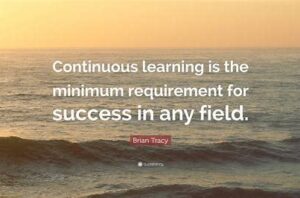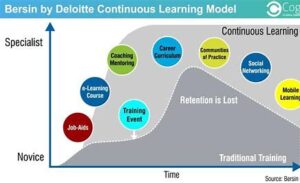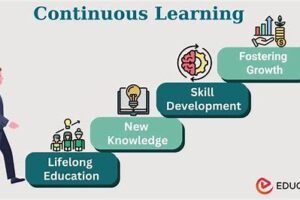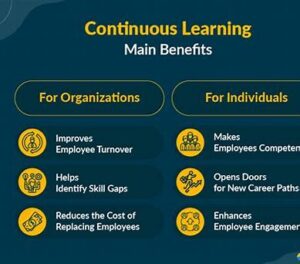Picture the modern leader. They’re not just managing resources—they’re navigating this whirlwind of change and innovation. Whether we’re talking about a CEO steering a Fortune 500 company, or a manager leading a small team, the game has changed. With rapid tech advancements, fierce global competition, and an ever-diversifying work culture, leaders today have a lot on their plate. Continuous learning is no longer optional; it’s like fuel for leaders needing to thrive in this fast-paced world.
Forget about the days whe

n once climbing the career ladder meant you could take it easy. Now, the landscape moves too quickly. Leaders need to stay fresh, absorb new insights, and adapt quickly to whatever the world throws at them. It’s like surfing hefty waves, constantly needing to balance, pivot, and reassess. In this sense, continuous learning is the surfboard keeping leaders afloat, allowing them to ride and not get wiped out by those big waves of change.
Here’s another angle: the link between a leader’s growth and their organization’s success. If a leader stagnates, there’s a good chance their team or company might too. But when a leader actively learns and embraces growth, it trickles down, inspiring the whole team to innovate and push boundaries. It’s like planting seeds that grow into a thriving garden. Cultivating a learning mindset encourages everyone else to reach for those new heights.
Fostering Adaptability: The Key to Successful Leadership
In today’s ever-shifting work environment, being adaptable isn’t just a nice-to-have trait; it’s a must-have that sets the great leaders apart from the rest. When leaders embrace continuous learning, they naturally become more adaptable, allowing them to face challenges head-on and pivot strategies without skipping a beat.

Adaptability in leadership means you’re ready to change course when needed, which is crucial during unexpected challenges—like tech disruptions or economic shifts. Ever noticed how some leaders manage to keep their cool and steer the ship when the unexpected happens? That’s adaptability in action, fueled by a constant commitment to learning.
A bit of real-world wisdom here: take a look at successful case studies. Think about industry pioneers and how they’ve evolved their approaches over time. Leaders like these show us the real power of staying flexible, especially in times of uncertainty. Their secret sauce is continuous learning, which keeps them ahead of the game.
So, how can leaders build this adaptability muscle? It starts with keeping a finger on the pulse of industry trends and being open to new ideas, even if they seem out there initially. Encourage feedback from your team—those different perspectives can offer fresh insights that prompt change for the better.
click here to start your own online business for free Ced0224

Consider setting up regular learning sessions within your team or organization. These could be short workshops, online courses, or even informal sharing of articles or podcasts. The goal is to foster an environment where learning and adapting are part of the everyday culture.
Enhancing Emotional Intelligence through Lifelong Learning
Emotional intelligence is like a secret weapon for top-notch leaders. While technical skills get you in the door, it’s the ability to connect, empathize, and understand your team that truly sets the stage for success. That’s where continuous learning comes in, helping to sharpen these people skills.
First, let’s break it down: emotional intelligence, or EI, involves being aware of your own emotions and the emotions of others. For leaders, this makes a huge difference. It’s what allows them to motivate, resolve conflicts, and create a positive work environment. With ongoing learning, leaders can enhance their EI and, in turn, boost team morale and productivity.
Consider emotional intelligence as a skill, just like any other. It doesn’t end at knowing the basics. There’s always more to grasp—new strategies in communication, better ways to provide feedback, or even understanding cultural sensitivities more deeply. Being open to learning about these aspects helps leaders improve their EI continuously.

Take some cues from leaders who are known for their high emotional intelligence. They build strong relationships with their teams, understand motivation beyond numbers, and navigate complex social situations with ease. Often, they’re the ones engaging in regular learning workshops focused on communication and interpersonal skills.
To start boosting your EI, embrace lifelong learning tailored to interpersonal growth. Books on EI, courses about handling difficult conversations, or even podcasts about active listening can be game-changers. Use this knowledge actively by practicing empathy, truly listening, and creating an inclusive culture where everyone’s voice matters.
Building a Culture of Innovation: The Leader’s Role in Promoting Learning
Leaders have a unique responsibility when it comes to fostering innovation within their organizations. They set the tone and create the conditions that allow creativity and fresh ideas to flourish. It starts with embedding a culture of learning, where everyone feels encouraged to explore new concepts and take calculated risks.
Innovation isn’t just about the latest gadget or cool tech; it’s about solving problems in novel ways. When leaders promote continuous learning, they equip their teams with the tools and mindset to think outside the box. They inspire curiosity and encourage their squads to question the status quo.
A big part of this is modeling the behavior. Leaders who actively engage in learning themselves set the stage for their teams to follow suit. It’s about walking the talk—showing that gaining new knowledge isn’t just for the newbies or the front liners, but essential at every level.
Creating a learning-friendly environment can be as simple as giving people the resources and time to develop new skills. This might mean providing access to online courses, setting up mentoring programs, or organizing regular brainstorming sessions geared towards idea generation.

Inspirational stories come from companies with leaders who’ve embraced this mindset. Consider spaces where teams feel safe to propose “out-of-the-box” ideas without fear of immediate dismissal. This breeds a culture where innovation is part of the DNA, and everyone contributes to the collective pool of know-how.
Emphasizing learning and innovation empowers teams, making them more resilient and capable of handling the ever-evolving challenges in the business sphere. This culture fosters loyalty and engagement since team members feel they are continually growing and contributing to something bigger.
Conclusion: Charting the Path Forward with Continuous Learning
Continuous learning is the engine that drives effective leadership, and it’s crucial for leaders to keep this engine well-oiled and running smoothly. The benefits are clear—adaptability, emotional intelligence, and innovation all stem from a commitment to ongoing education. But beyond these, there’s the power of setting an example. When leaders prioritize their own learning, it inspires others to do the same, creating a ripple effect across the organization.

Building a personal roadmap for learning is a great first step. By identifying areas needing growth—whether it’s technical skills, emotional insights, or creative problem-solving—leaders can target their efforts and maximize the impact of their learning.
The future is exciting, with endless possibilities for exploration. This forward-thinking mindset, coupled with a healthy dose of curiosity, ensures leaders are not just keeping up but leading the charge in shaping the future. Being open to new ideas and perspectives keeps leaders influential and relevant in an ever-changing world.
Continuing the journey of learning speaks volumes about a leader’s dedication to excellence and progress. By encouraging an atmosphere that celebrates learning, leaders offer their team a glimpse of infinite potential and boundless opportunities, set against the backdrop of a bright and dynamic future.
